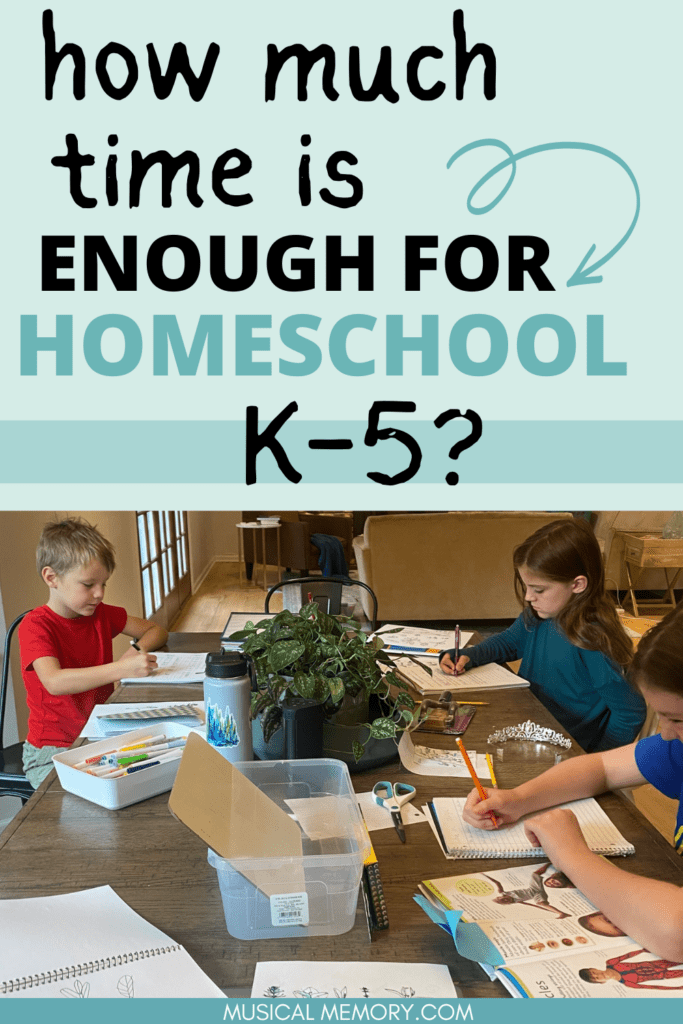The short answer is: much less time than traditional school. If you’re asking specifically about how much time sitting at a table, working on book work, then here are my recommendations.
We’ve been homeschooling for 6 years as of this writing and our 4th kid is in kindergarten now! Hard to believe!! All 4 of our kids have been reading before age 6 and generally seem to love learning (including math!!) I think keeping lessons short & focused is a key part of an enjoyable homeschooling life- for kids & parents alike!!
- Less than an hour of desk/ table type work in kindergarten & 1st grade
- 45-60 minutes for 2nd-3rd
- 1-2 hours for 4th grade – 5th grade
- For middle school and high school students, the amount of homeschool hours spent on bookwork really depends on the approach you take to homeschooling in these years, whether or not you’re going to aim to have them complete some college course work at home, how much they’re working at an outside job, etc.
BUT, there is much more learning going during the day than what gets completed at the table. This statement should be every homeschool household’s mantra!!
The long answer is, well, longer. Homeschooling isn’t standardized. As a homeschooling family, you get to call the shots for what to focus on and how to spend your time. Do only formal lessons “count” for school time? What about activities such as an online wood working class, music lessons, or a co-op with other families? Do those “count?” (Yes!)
So, let’s take a closer look at what homeschool families’ days look like, and the most common questions related to how much time you should spend homeschooling.
Life Outside the Box – Rethinking School
The majority of current homeschool parents grew up in public school, myself included. In regular ol’ school, children are sorted by grade level and spend 7-8 hours in school, at least 180 days a school year.
Presumably, if you opted out of that system, you’re already inclined to think… okay, that’s not what I want to replicate. Home school can look different, right?
But then, as new homeschooling parents, we sit down to make a homeschool schedule and go right back to that structure & system.
Because it’s all we know.
It’s hard to think outside the box when your entire life has been spent in the box.
I think I had a color coded spreadsheet of subjects when my oldest child turned 5 and we started homeschooling kindergarten. (Which of course makes me chuckle now… but you don’t know what you don’t know. And that’s okay.)
Here’s the thing about learning at home… Learning academic concepts and skills is much more efficient when taught one on one.
And everything else you do in your daily life counts for learning.
Think about it. If your young child explores in the back yard, collects rocks & pinecones for their pretend house, then sorts them all out as different types of pretend food, would that count as less learning or more learning than a sorting worksheet from a kindergarten math workbook?
What if your older child uses Youtube to teach themselves how to crochet? And then turns around and teaches and eager younger sibling how to crochet… Is that less learning than a 4th grade art class?
School at home might look different, but it’s not like the learning style dictates whether or nor learning has happened.
Everyone knows from their own experience that if you can do it for yourself, you have truly learned it. And it’s much easier to acquire new information, skills, and ideas through hands-on learning.
So, yes, we complete regular math curriculum, teach our kids to read and spell using phonics, complete cursive workbooks, and memorize history time lines. But the day to day hourly break down of a typical homeschool day, and the hours of school work our children work don’t really translate or compare well to the public school system.
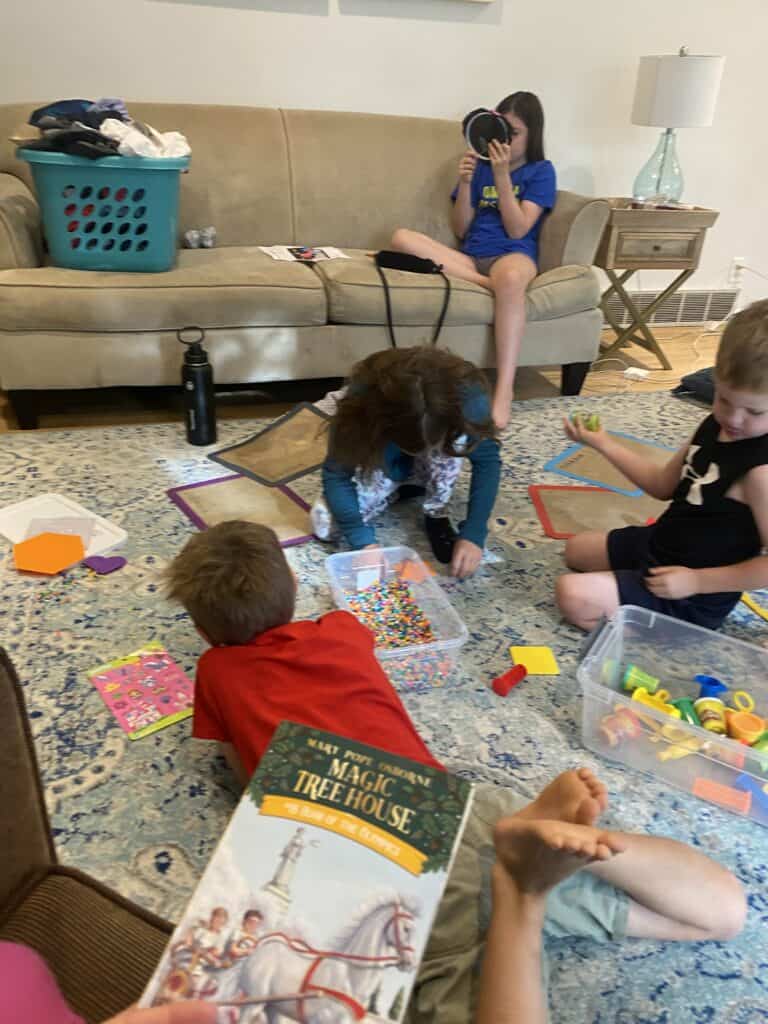
We also don’t need to sort out “school,” from education. Education is an ordering of the our affections. Learning to love what we ought, learning how to do what’s necessary. Education is exchanging ideas and conversing well. Learning to both articulate cohesive ideas and be a good listener. Education is learning to pay attention and consider others’ needs above your own. All of that doesn’t only happen when sitting at a desk, copying sentences into workbooks. (Although, there is a time for copywork, too)
Young children learn through play, older children learn as they explore their innate interests. We learn when we’re reading great books in front of the fire place or listening to Dad tell an interesting story about running his business.
RELATED: Astronomy Picture Book List
Life at home with your family is full of education. So, in one way I’d say we spend about 14 hours a day homeschooling… all the hours my kids aren’t sleeping. It’s really hard to believe all of that deep down until you see it first hand, and that’s okay too. Your home education journey will evolve over time. It’s a learning process.
Welcome to life outside of the box!! Haha
Side note – a great book on this topic is aptly titled, Rethinking School. It was written pre-pandemic but feels almost prophetic in terms of what many parents realized about public school once their kids came home for ‘zoom school.’ Did you know there were ~2.5 million homeschooled kids in America at the beginning of the 2019-2020 school year? At the beginning of the past 2022-2023 school year, there were ~ 5 million homeschooled kids. 😲
Okay, but for real… the Nitty Gritty
I’ll step off my soap box now and try to be practical in answering the question how many hours a day should you spend homeschooling? It’s totally valid for new homeschoolers to wonder… how long should this whole homeschool gig take?
I’m going to focus on people who are new to homeschooling their younger kids. If you’re diving into homeschool for the first time during the high school years, head over to Lee Binz’s website, Homeschool High School Help. She’s THE go-to person on homeschooling through high school.
For people with elementary school age kids at home, the rest of the post is for you!
If you are starting to homeschool with a 4-6 year old for the first time, you might feel like – well, I purchased language arts & math programs and we did a lesson of each in less than an hour total. Then we read a chapter book for 20 minutes. So now what?
Or maybe you have other young children at home, and you’re thinking, there is no possible way I can fit all the subjects in between feeding the baby, making sure my toddler doesn’t destroy the house, working out, MOPS, and getting a hour to myself in the afternoons.
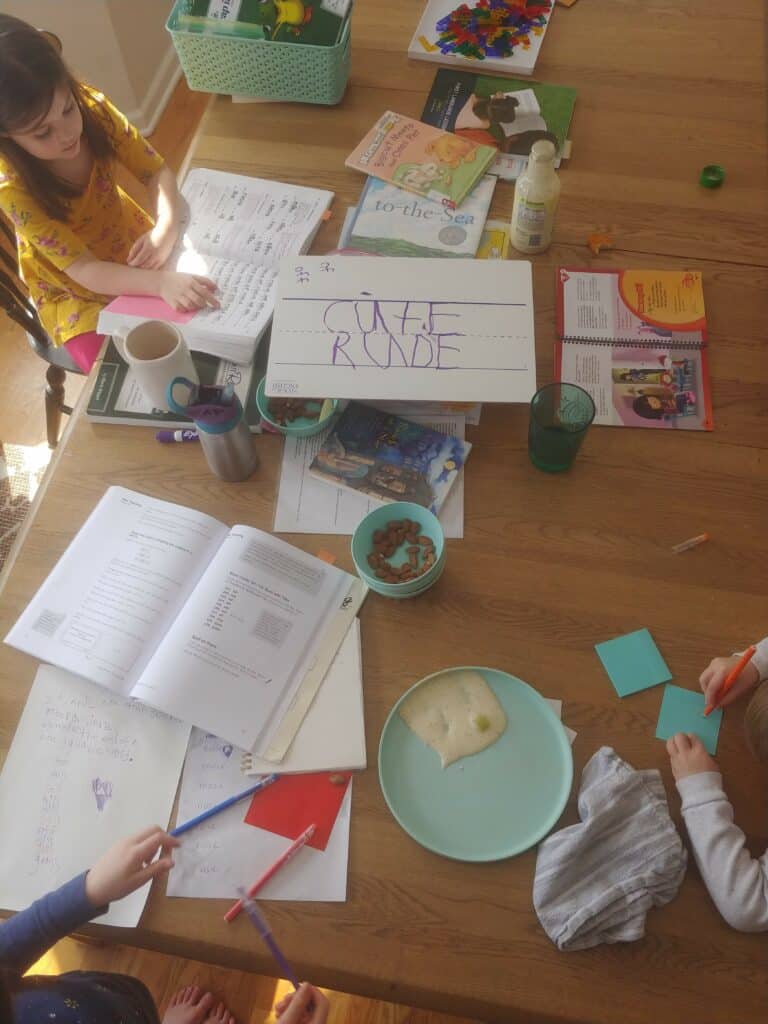
As a new homeschool mom, I felt so nervous about making sure we were doing enough.
I wanted to know the magic amount of time for first grade math. Were we doing enough? How do I know if what I’m doing hits the specific requirements for my state’s homeschool laws? Do I need a lesson plan notebook? Do field trips have to include comprehension workbooks? Shouldn’t school take 3-4 hours at least? More is more! What should my daily schedule be?
5 years later, I’d go back and tell myself the same thing I tell all new homeschooling moms I talk to now. “Take a deep breath & try not to worry about it. The only way to figure it out is to just start doing it. Your homeschool will likely look different each year as you and your children learn & grow together.“
Categories of Learning for the Younger Years
Rather than asking “how much time do we spend on school,” as if school is separate from the rest of life like it is in a traditional school experience, it’s helpful to think about ‘school’ at home in a few different categories:
- Kitchen table/ desk work – handwriting workbooks, math lessons and practice, learning to read, etc.
- Reading aloud which can cover history, geography, social studies, science, literature, comprehension, oral composition, music & art appreciation, and so much more
- Hands-on planned activities – learning to follow a recipe & cook, sew, a themed art project, a science demonstration
- Play – younger children primarily learn through play. Resist the notion that your 3-5 year old child needs hours of structured learning opportunities. Do a little digging and you’ll find there are mounds of research showing that children in a safe, intentional home environment with hours of unstructured play time fare better in future school-related learning than kids who started in “early childhood learning” (what we think of as preschool) in their preschool age years.
- Life – the countless number of hours your children spend interacting with siblings, playing with neighbors, exploring outside, building legos & magnatiles, creating pretend worlds, putting on silly living room performances, making homemade drawings for grandparents, going on outings with grandparents, cleaning their rooms, learning to help out at home, picking healthy food at the grocery store… these experiences go a long way into educating the whole child.
- Bonus skills that require specific teaching or materials – art, piano lessons, coding, typing, etc.
Kitchen Table Work Time (PreK-5)
The first thing on that list above is work that could be categorized as “kitchen table work.” Not that you’ll necessarily sit at a kitchen table or desk to do it… you might as well sit on the front porch if it’s nice out.
But, anything that you sort of traditionally think of as “school work” – things like handwriting, math lessons, and spelling practice – might fall into this category. Regardless of the age you decide to start ‘formal school’ at, the early days of doing school work will require a small amount of hours.
My main suggestions for these subjects are: choose curriculum that keeps things varied (or combine programs to create variety) and keep lessons SHORT.
- Variety – Here is an example of how to create variety with handwriting lessons for a 4- 6 year old.
- Dry erase markers
- Sand tray
- Dry erase ABC tracing books
- Basic handwriting workbooks – my 4-5 year old favorite; my 5-6 year old favorite
- Do fine motor “pincher” activities to build the pincher grasp.**
**NOTE – If your child is holding writing utensils in a weird way, buy pencil-grip specific writing tools AND do a lot of fine motor activities to build the pincher grasp. Once your child can form the letters and read basic words, rather than buying a “handwriting curriculum,” write out words in an empty handwriting notebook while the child watches you and then let her trace or copy what you wrote. Kids think that it’s funny to copy one word at a time and form a silly sentence. 10 minutes a day is enough for this skill. The easier writing gets, the more the child will practice on his own anyway in organic ways throughout the day.
- Short Lessons – Skills can be learned well with 10 – 20 minutes of focused attention. Charlotte Mason was big on short lessons & the habit of attention. If your child can write the letter B beautifully 3 or 4 times, why require her to copy it 20 times? The longer we’ve homeschooled, the more I focus on quality over quantity. You should end lessons while everyone is still enjoying them so that you can enjoy it tomorrow. Don’t teach until you’re both sick of it, otherwise, you’ll both burn out in 2 weeks.
Here’s the breakdown of how much time my 4-11 year old children spend on math, learning to read, learning to writing & spelling. I teach everything else family style and allow lots of free time for natural learning and interests.
Book Work 4 – 5 Years Old
Though I tried a lot of things with my first child, and spent lots of unnecessary time on preschool fluff, I approach preschool & kindergarten much differently now. Any lessons we do are extremely efficient. I fit a lot more of their skill work into every day life as they’re interested; most of their learning comes through play & books.
I aim for 10-15 minutes of each skill, 3-5 days a week with a 4-5 year old. And, all our kids have been reading by age 5.
Most preschool aged children naturally become interested in letters and writing because they observe mom reading and writing. I have a whole post about figuring out if your child is ready to read.
But once they are, you do not need to run out and grab a 60-minutes-a-day-all-in-one-langauge arts program. You can just teach them a few letter sounds in 10 minutes and move on with your day. Grab a mini white board to demonstrate how to write letters. Let them watch you write a letter on a piece of paper and then trace over it using a fat marker. Do this a few times a day, whenever they’re interested, a days a week, adding a few new letters every week. (Here’s my entire process of teaching our kids to read.)
Write their name in large letters in pencil on a blank piece of paper. Pop it in a plastic page protector and let the child practice writing his name in dry erase markers. Print a free ABC tracing page & pop them in dry erase sleeves too. If you want a cutesy program to work through, the Good and the Beautiful preschool kit is perfect!
I’ve been using this with our 4th child, along with my phonogram kit so that he learns phonogram sounds rather than just letter sounds. TGTB preschool is inexpensive, requires no prep on the parent’s part, and has a good mix of “hands on” and worksheet type stuff. My 4 year old boy loves it! It’s been the perfect amount of school-work for him to feel like the big kids.
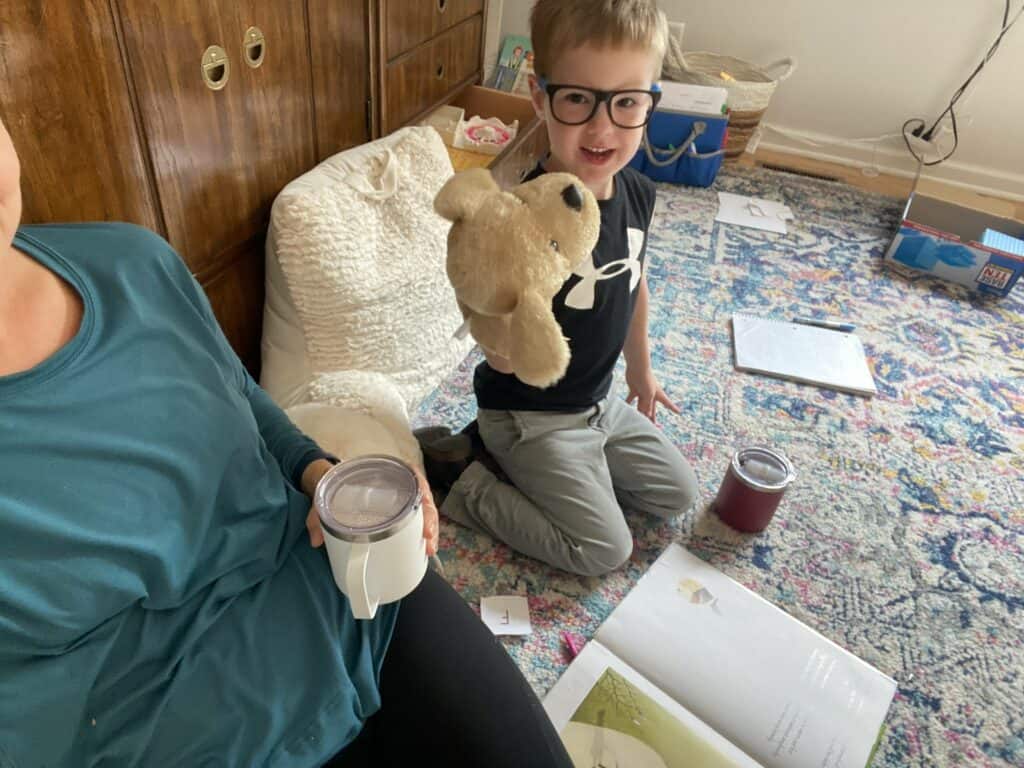
Book Work 1st Grade ish
Our first grader spends about 15-30 minutes on independent work 3-4 days a week. This might include math facts practice, poetry review, copywork (print/ handwriting), and/ or working through a cursive instructional workbook.
Plus we do a math lesson together 4 days a week – just getting through as much as we can with a 20 minutes timer. We usually complete 1 lesson & a 5 minute fact review game. I use Singapore’s Primary Math 2022 with a variety of hands on materials & Addition/ Subtraction Facts That Stick for my first grader.
We also do 10-15 minutes of spelling instruction 3x a week.
We read aloud at a level that’s challenging to him for 10-15 minutes, 3-4 days a week. We sit side by side, snuggled on the couch, and alternate who reads aloud each sentence, paragraph, or page.
Book Work 2nd Grade ish
2nd Grade would look very similar to 1st grade in our home, except each thing would take a little bit more time since the lessons in our chosen curriculum gradually get a little longer.
With a second grader, I’d spend about 20 minutes on 1-on-1 math instruction, 15 minutes on spelling (3x/ week), and 15 minutes reading aloud at a challenging level (3x/ week).
Then I’d add a few things to the child’s independent list… things like math worksheet to reinforce the lesson concepts or for fact review, practicing/ reviewing poetry on his own, a guided typing program, copying spelling words on the days we don’t do spelling instruction.
The above independent work for a 2nd grader might take 20-40 minutes depending on the day.
Book Work 3rd Grade ish
I have a 3rd grader this year.
We do 25 minute math lessons 4x a week (1 on 1 instruction plus a fact review game), 15 minutes of spelling 3x a week, 10-15 minutes of reading aloud together at a level that’s challenging for her a few times a week, and 15 minutes on a writing lesson 2x per week.
Her independent list takes about one hour, 3-4 days a week and includes a wide variety of things- math fact practice, spelling word work, copying her own compositions for a writing class, illustrating her stories using online drawing videos, typing programs, math worksheets, etc. (I don’t assign every subject/ task every day.)
Book Work 4th-5th Grades
My 4th-5th grader’s work load is similar to 3rd, except her writing lessons take a little bit longer & the writing assignments have grown gradually in length. She doesn’t really spend that much more time on schoolwork than our 3rd grader; she just gets through more in the same period of time because she’s a bit older & works a little more quickly.
Middle School
I’ve never had a middle schooler, so I don’t know how long to plan for this age yet. I expect math to take close to an hour as it gets more advanced, and to assign a little more independent reading, more extensive writing (increasing gradually), and perhaps helping a younger sibling with a subject area for fun.
What About All the Other Subjects?
A few years into homeschooling, I stumbled upon the idea of “morning time.” I don’t even know where I first heard about it, but it’s an AMAZING method for teaching a bunch of kids, across a wide age range all the “extra stuff,” that you want to get to but doesn’t quite fit in the day… Shakespeare, poetry, art, music, geography, biographies, drawing lessons, watercolor, sight singing, online classes, WHATEVER!!
Anything you want to teach to all of your children or to learn together can be done during morning time.
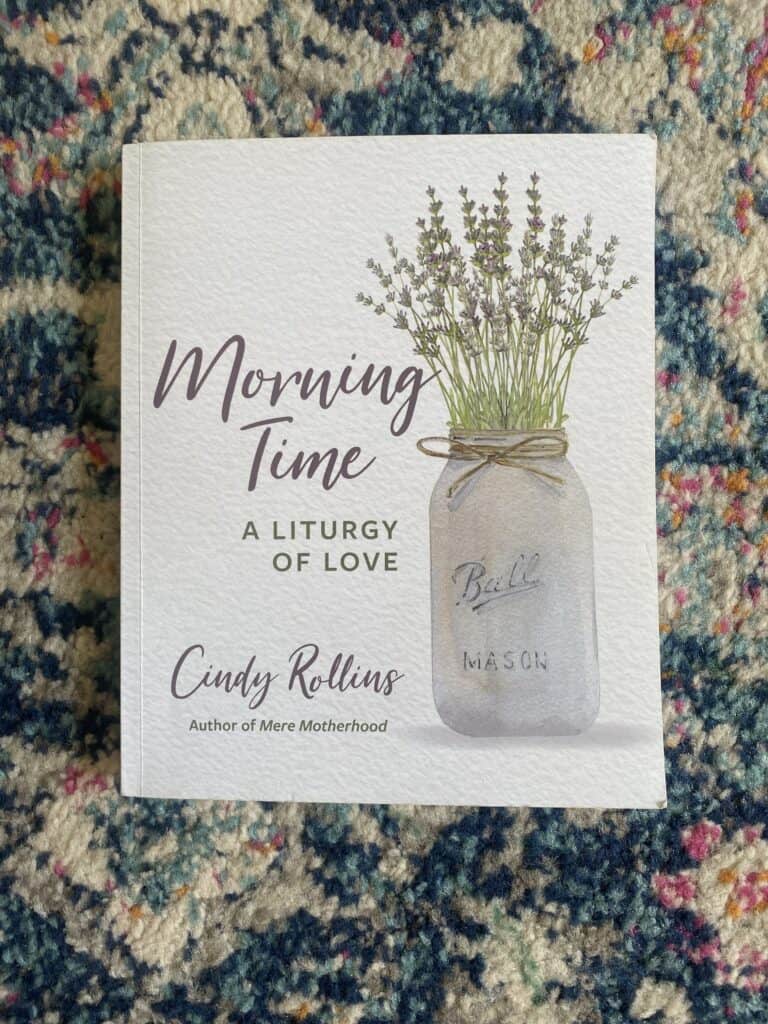
The basic idea of Morning Time is – group as many things at you can together and teach them family style. Many families choose to do this work earlier in the morning, before everyone goes their separate ways to work on book work. However, I know some families that choose to do this fun learning around lunch time, at the end of the book work time.
We do morning time alongside breakfast for about 60-90 minutes, 3-4 days a week. During this time, we have a few things we do daily and a few things we sort of rotate through. We start at the breakfast table, then move to the family room floor for the kids to spread out and play with quiet activities while we finish reading.
DAILY – Every day we read the Bible, sing a hymn, sing our memory work songs, and practice the poem we’re currently memorizing. We also spend a couple minutes reviewing either phonograms, spelling rules, or latin vocabulary. (These tasks are from our spelling program & I just do them with all the kids together rather than spending time with them during individual spelling lessons.) Lastly, we spend 3 minutes on one area of memorization review. (I have a running list.)
LOOP WORK – Then, we spend about 20-30 minutes looping though various things – reading poetry for enjoyment, studying a painting by our current artist, something music appreciation related, working on maps, finding Bible verses, reading Grammar Island, drawing lessons from Youtube, etc…. You could literally add anything you want your kids to learn to this section of “morning time.” Pick 4-5 things and just rotate through them for 20 minutes. Get to as many as you can one day, and then pick up the next day wherever you left off.
READING – The last 30 minutes of our morning time is spent reading aloud. I read from picture books, a current literature selection, our history book spine, a biography, a science book, whatever. I have a giant stack of books I’m always working out way thought and read from a few different books, for about 10 minutes each. We also listen to audiobooks in the car and sometimes at night, which of course “counts” of reading time. It all counts! 🙂
The tips about variety and short lessons apply to morning time as well. Get a BIG stack of interesting, living books – books that make a subject or person “come alive” to you. Rotate through each thing for about 10 minutes each. Make sure you don’t do the same things every single day, for variety. You can teach so many things in a one-room-schoolhouse format.
Simple + Hands On Science
I could do a whole separate post about science in the early years, but for now, I’ll just mention that you don’t need to block out tons of time for explicit science instruction in the early years.
Spend lots of time outside together, read Charlotte Mason’s thoughts about teaching science through nature to young children. You might consider grabbing an open-and-go science unit from The Good & The Beautiful once your oldest child is in about second grade.
Watch the Magic School Bus, read amazing nature books (we love Seymour Simon), visit the zoo, raise caterpillars, cook & bake, maybe borrow some chicks to hatch.
And then, I recommend using our science memory work albums too! The science songs are some of the kids’ favorites & they spark lots of interesting questions & conversations. Like, the week we learned the black hole song, my 5 year old wanted to get MANY books about black holes from the library. We read & talked about them all week. Who needs forgettable worksheets when you can sing the terms & definitions and memorize them for life!?
I’m all about songs + books + nature for science in the early years. The combination of these 3 things provides such a good foundation for future science study as kids get older.
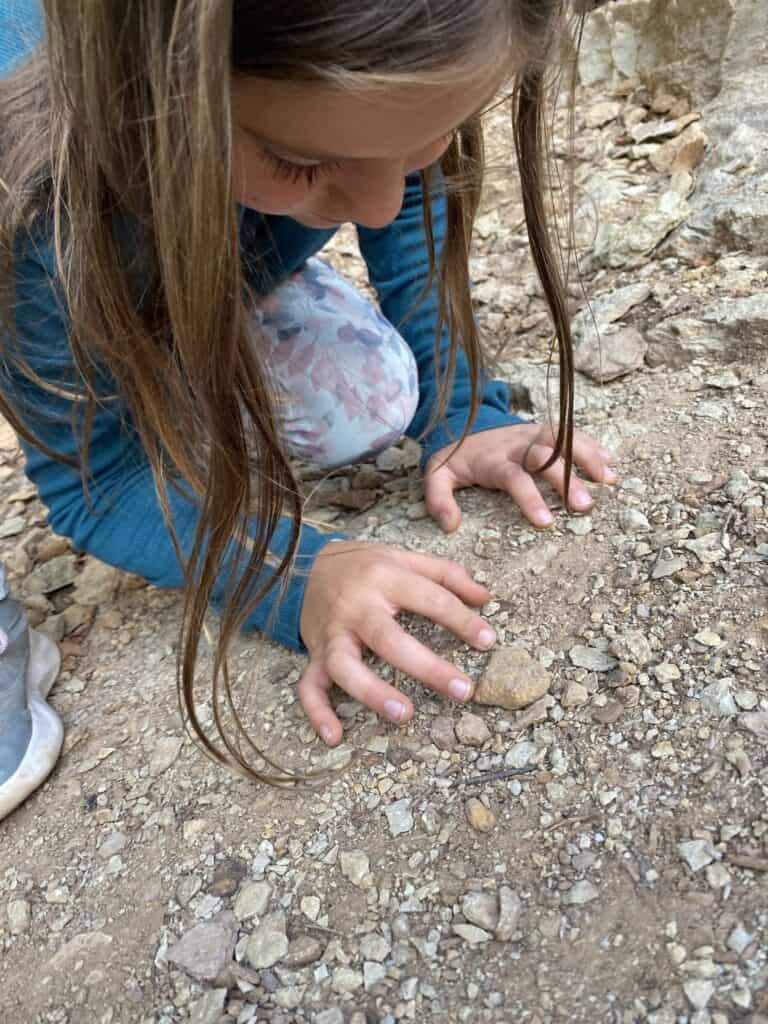

Our Current Daily & Weekly Schedule
Hopefully, buy now, you see how varied a school day can be! I’ll share our daily/ weekly schedule but just know that it’s evolved a lot. I share it as an example, not as a “goal,” of any sorts.
I have several close friends who homeschool and most of our days look very different from one another. The beauty of homeschooling is you tailor it to your family’s life & priorities.
3 days a week, our day looks like this:
- Chores/ personal care before breakfast
- 8:00 – breakfast & morning time (variety of family subjects listed above)
- 9:30 ish – I work with my preschooler for 20 minutes. Big kids choose to have free time or get started on school work.
- First lesson rotation starts – we take turns doing independent school work, music practice, and lessons with me. 20-25 minutes and then switch.
- Second lesson rotation starts. I usually have chopped veggies & healthy snacks out at this point so that kids often help themselves to snack-style lunch if they want.
- I finish up feeding anyone lunch that needs it.
- Free time/ quiet time/ rest time for the early afternoon hours
- violin lessons once a week in the mid afternoon
1 day a week, we do a “co-op” with a couple other families in the morning. During this time, we practice memory work, sing a hymn & folk song, the kids share/ present different things to each other (sort of like show-and-tell, for regular public speaking practice), and we do science. Then they all play. Once a month we switch this out for a field trip/ outing of sorts.
Friday is a light school work day & life-catch up day for us. The kids earn chocolate chips or pennies or m&ms for reciting various memorization things to me. They finish up any remaining independent work that was assigned & practice for music lessons. They thoroughly clean their bedrooms & helps with bathrooms. Usually someone is doing their laundry. We go to the library and we go to a multi-age gymnastics class they can all participate in. If we want to hang with friends or do a special outing, this usually happens on Friday too.
Every year looks a little different for us. We’ve sort of gradually aged out of schooling with babies & toddlers around. The more school aged kids I have, the more intentional I have to be with keeping lessons short & staying on task so I get to everyone. The above daily rhythm works for us for now, but I hold it loosely, knowing it very well may change in the future.
Brand New to Homeschooling Kindergarten?
We’re 5 years into homeschooling, and our youngest is 4 1/2. His preschool years have looked SO different from my oldest’s.
If my oldest was 5 all over again, here’s what I’d do:
- Feed everyone breakfast (when my oldest was 5, we had a 4 year old, 2 year old and newborn!)
- Sit in the family room & read aloud for as long as everyone’s happy (while they play quietly nearby)
- Go outside or on an adventure & play learning songs in the car… I have a preschool learning playlist for things like days of the week, books of the bible, ABCs, etc. Plus I’d start our memory work songs around 4-5 year old.
- During baby/ toddler nap time – I’d teach my 5 year old 15-20 minutes of math (in a hands on way!) and 15-20 minutes of spelling/ reading lessons
- Enforce quiet play/reading time for all kids for at least 60 minutes – part of which overlaps with baby/ toddler naps, so I can have a break!
- Give the child a short amount of “independent work” that they can complete with a little help from me, while I’m nearby giving after-nap snacks. (If the child isn’t interested, I’d wait until closer to 6.)
- Have the child learn to help out around the house, do his own laundry, complete basic chores, etc.
- Go to the library at least once a week
- Send the child outside every day – make sure she has ample unstructured play time
- Go back to the same nature spot often
- Spend time with other families and grandparents, cousins, neighbors, etc.
No “Right” Amount of Time to Spend on Homeschooling
You probably need to spend less than you’d think, even on the core subjects. Just remember – 1 on 1 learning is very efficient. It’s okay if things get done quickly. It leaves time for rabbit trails, great books, and life together.
Fill the time with more valuable things like building relationships, learning interesting skills, listening to memory work songs, and reading aloud.
If you’re just getting started on your homeschool journey, here are some other posts you might like:
- 51 Homeschool Supplies List – things we use all the time and love
- Top 11 Essentials Supplies List – the necessities & basics for new homeschool families!
- Creating a homeschool schedule that works for YOUR family
- Why Memorize with little kids!?
